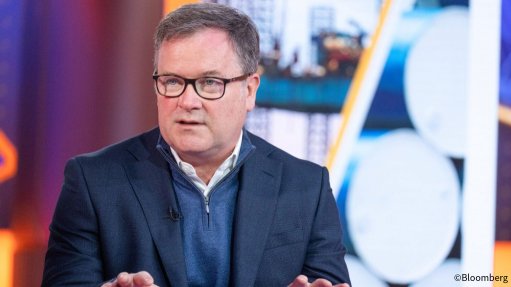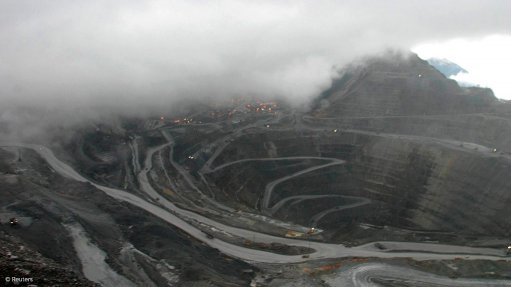Digital holds opportunities for mining R&D innovation
It is challenging to innovate in research and development (R&D) in mining, owing to some of the industry’s inherent characteristics; however, digital as an R&D option is opening up new opportunities for mining technology adoption.
The was indicated by dual-listed Sibanye-Stillwater technology and innovation head Alex Fenn, delivering the keynote address during the University of the Witwatersrand's (Wits') DigiMine seminar on December 10.
Fenn mentioned that mining was a complicated industry, with different operational challenges and requirements across each commodity, making use of different processes. This makes it difficult to establish a generic solution.
Moreover, he noted that the market for new technology in the industry was usually not big enough to justify the R&D investment.
Further, the industry was risk adverse and highly regulated, therefore, it historically looked internally for solutions, which diluted R&D focus considerably, Fenn said.
However, he noted that digital presented opportunities to open up R&D in the industry.
Fenn said digital was an industry agnostic concept, meaning that it was open to any industry for exploiting. Therefore, he advised mining companies to look outward at technology concepts, developed in other industries, that were potentially applicable to the industry’s value chain.
However, he noted two roadblocks to this. Firstly, that mining organisations are not structured to capitalise the vast opportunity beyond adoption, that digital presents.
Secondly, he said the industry was still digitally nascent. “A lack of digital, or data, density across a vastly complex value chain limits our ability to adopt off-the-shelf technology without additional R&D,” Fenn said.
Therefore, while there were new opportunities in digital, the mining industry was still behind the curve and required R&D and a new way of working, Fenn emphasised.
In this regard, he noted that digital innovation required the establishment of new operating philosophies, including digital agility, digital talent, capability design and digital leadership.
Fenn emphasised that the mining industry needed to consider all R&D ecosystem phases to be truly digitally disruptive.
He elaborated that these phases were fundamental research, applied research, prototyping, pre-commercial variant and commercial variant.
However, he lamented that the industry's investment in these phases was relatively imbalanced and that the industry investment profile therefore did not support effective and end-to-end development of technology.
In response to this, he indicated that Sibanye had developed key objectives to improve the situation.
These were access, influence, responsibility, balance, agility and maturity.
Fenn pointed out that the company had long-standing relationships with Wits and the University of Johannesburg through anchor funding agreements, which allowed it access to a wide network of information when exploring new technology options for the industry.
Moreover, these universities have an extensive partnership network in the mining and technology network, locally and internationally, which helps Sibanye to assess potential applicability when exploring technology innovations.
He noted that these relationships enable an effective “solution factory” in support of the company; helping it to establish a comprehensive R&D ecosystem.
With regard to the latter, he indicated that considerable strides have been made by Sibanye in the fundamental, applied and prototype phases. The company is also making inroads into the pre-commercial and commercial phases, through selected startup and scale-up partners, and selected commercial strategic partners respectively.
Fenn noted that it was important for Sibanye to look inward and establish a culture, structure and process to ensure the company is able to lead the adoption of digital technology and innovation.
However, he emphasised that to be truly digitally disruptive, the industry must look outward and evolve its thinking to address key limitations, broaden horizons, develop fit-for-purpose solutions and maximise returns on R&D investments.
DigiMine R&D
Wits DigiMine head Ahsan Mahboob, meanwhile, expanded on the entity’s research cycle.
The first stage is exploration, that is, identifying a real-life problem in the mining industry.
Secondly, there is R&D, during which the problem is presented to the appropriate student who finds possible solutions.
Thirdly, there is testing the chosen solution, which is done using a prototype.
Fourthly, the solution is validated; and fifthly, it is optimised to minimise errors and maximise benefits.
Lastly, there is deployment to the mining industry.
DigiMine leverages is partnership with Sibanye to apply its optimised solutions in a real environment, he indicated.
In terms of DigiMine projects that have been fast-tracked for 2019 to 2020, Mahboob mentioned seven.
These include designing a geographic information system to manage tailings storage facilities in near real-time; application of numeric modelling to gold and platinum mines to evaluate rock stresses and rock-bursts for support design; and application of numeric modelling to model and simulate the effects of mining ventilation as a mechanism for transferring Covid-19 as well as smoke, noxious gases and heat during underground fires within different mining layouts in gold and platinum mines.
Moreover, there is time and spatial tracking of metal content from in-situ to plant entry; a digital mining technology approach; analysis of specific absorption rates in humans for wearable wireless devices in underground mines; and improvement of the methods and designs of personal protective equipment for the mineworkers, including for emerging infectious and viral disease control.
Lastly, there is the DigiMine Techathon, an open innovation competition. Mahboob explained that the main objective of this was to generate high-value actionable research ideas and product concepts to solve real world underground mining problems.
AI IN MINING
Wits Mining Institute director Fred Cawood mentioned that artificial intelligence (AI) would be visible throughout the mining value chain in the next five years – while not at a perfect level, it will be part of the industry, and progressing.
In this regard, he noted several challenges posed by AI for the industry, namely that it is undertaking this in an entirely harsh and unfriendly environment; that the country does not have the cluster of talents that Europe, the US and the East have; affordability; and having to find ways to undertake it in a way that allows for upscaling.
However, he said AI did present several opportunities, namely inclusion in a business strategy; and pursing data first, and then integration.
Moreover, there was integrating data for analysis; and integrating capacities through networks. For the latter, Cawood emphasised that one organisation or university could not do this alone, but rather, collaboration was required for AI in mining to become part of the national system of innovation.
Lastly, he said mine modernisation and AI could be used as a foundation to create jobs for the tech-savvy youth of the country and continent.
Cawood said the region had access to a diverse, technology-adept population, and this could be capitalised on to create jobs for this demographic.
Comments
Press Office
Announcements
What's On
Subscribe to improve your user experience...
Option 1 (equivalent of R125 a month):
Receive a weekly copy of Creamer Media's Engineering News & Mining Weekly magazine
(print copy for those in South Africa and e-magazine for those outside of South Africa)
Receive daily email newsletters
Access to full search results
Access archive of magazine back copies
Access to Projects in Progress
Access to ONE Research Report of your choice in PDF format
Option 2 (equivalent of R375 a month):
All benefits from Option 1
PLUS
Access to Creamer Media's Research Channel Africa for ALL Research Reports, in PDF format, on various industrial and mining sectors
including Electricity; Water; Energy Transition; Hydrogen; Roads, Rail and Ports; Coal; Gold; Platinum; Battery Metals; etc.
Already a subscriber?
Forgotten your password?
Receive weekly copy of Creamer Media's Engineering News & Mining Weekly magazine (print copy for those in South Africa and e-magazine for those outside of South Africa)
➕
Recieve daily email newsletters
➕
Access to full search results
➕
Access archive of magazine back copies
➕
Access to Projects in Progress
➕
Access to ONE Research Report of your choice in PDF format
RESEARCH CHANNEL AFRICA
R4500 (equivalent of R375 a month)
SUBSCRIBEAll benefits from Option 1
➕
Access to Creamer Media's Research Channel Africa for ALL Research Reports on various industrial and mining sectors, in PDF format, including on:
Electricity
➕
Water
➕
Energy Transition
➕
Hydrogen
➕
Roads, Rail and Ports
➕
Coal
➕
Gold
➕
Platinum
➕
Battery Metals
➕
etc.
Receive all benefits from Option 1 or Option 2 delivered to numerous people at your company
➕
Multiple User names and Passwords for simultaneous log-ins
➕
Intranet integration access to all in your organisation





















